Ahmed Shawqi facts for kids
Quick facts for kids
Ahmed Shawqi
أحمد شوقي Amīr al-Shu‘arā’
|
|
|---|---|

Portrait of Ahmed Shawqi.
|
|
| Born | October 17, 1868 Cairo, Khedivate of Egypt |
| Died | October 14, 1932 (aged 63) Cairo, Kingdom of Egypt |
| Occupation | Poet, playwright |
| Language | Arabic |
| Alma mater | University of Paris Université Montpellier |
| Genres |
|
| Literary movement | Arab Neoclassicism |
Ahmed Shawqi (1868–1932) was a very famous Egyptian poet and writer. People called him the Prince of Poets (Amīr al-Shu‘arā’). He is one of the most important Arabic writers in the Arab World.
Contents
Life of a Poet
Ahmed Shawqi grew up in a rich family in Egypt. His family had roots from different places like Circassia, Turkey, Kurdistan, Egypt, and Greece. They were well-connected with the ruler of Egypt, called the Khedive.
After finishing high school, Shawqi studied law. He also got a degree in translation. The Khedive, Abbas II, offered him a job at his court, which Shawqi quickly took.
A year later, the Khedive sent Shawqi to France to study law even more. He spent three years at universities in Montpellier and Paris. While in France, he loved the plays of French writers like Molière and Racine.
Shawqi came back to Egypt in 1894. He became a very important part of Arabic literature. But in 1914, the British government forced him to leave Egypt. He went to live in southern Spain, in a region called Andalusia.
He stayed in Spain until 1920, when he was allowed to return to Egypt. In 1927, other poets gave him the special title Amir al-Sho’araa’, meaning "the Prince of Poets." This was to honor his huge contributions to writing.
Before his exile, Shawqi lived in a house called ‘Karmet Ibn Hani’ near the Khedive’s palace. After he came back to Egypt, he built a new house in Giza. He also named this new house Karmet Ibn Hani. He met a young musician named Mohammed Abdel Wahab and helped him start his career. Mohammed Abdel Wahab later became a very famous Egyptian composer. Shawqi’s house is now the Ahmed Shawki Museum.
Ahmed Shawqi's Works
Ahmed Shawqi’s writing career can be divided into three main parts.
His first period was when he worked for the Khedive. During this time, he wrote poems praising the Khedive and supporting his policies.
The second period was when he was in exile in Spain. He missed Egypt very much. His poems from this time were about his love for Egypt and the wider Arab world.
The third period began after he returned from exile. He started writing about the amazing history of Ancient Egypt and Islam. He also wrote religious poems, praising the Islamic prophet Muhammad. During this time, his writing style became very strong, especially in his plays.
Plays by Shawqi
Ahmed Shawqi was the first writer in modern Arabic literature to create plays written in poetry. He wrote five serious plays (tragedies):
- Majnun Laila (meaning "The Mad about Layla"), which was his first play.
- The Death of Cleopatra
- 'Antara
- Ali beh el-Kebeer
- Kambeez (Cambyses II), written in 1931
He also wrote two funny plays (comedies):
- El-Set Huda (Madame Huda)
- El-Bakhila (the Miser-ette)
And one play written in regular prose, not poetry: the Princess of Andalusia.
Shawqi's Poetry
- Esh-Shawqiyyat: This is a collection of his best poems, in four books. It includes Nahj al-Burda, a poem honoring Muhammad.
- The States of Arabs and the Great Men of Islam: A long poem about the history of Islam.
- Poetic Stories for Children: These were inspired by the famous French writer of fables, Jean de La Fontaine.
Prose Works
He also wrote some prose (regular writing, not poetry) pieces. These were collected in a book called The Markets of Gold.
Ahmed Shawqi's Legacy
Ahmed Shawqi’s home in Giza, Karmat Ibn Hani', became the Ahmed Shawki Museum on June 17, 1977.
His works are often celebrated at the El Sawy Culture Wheel, a cultural center in Cairo.
In 2010, the web search engine company Google honored Shawqi with a special Google Doodle. This was for what would have been his 142nd birthday. The Doodle showed a quote from his poetry that means: My homeland is always in my mind even if I were in paradise.
There are two roads named after Ahmed Shawqi in Giza. One is Ahmed Shawqi Street, where his museum is located. The other is Ahmed Shawqi Corridor. Statues of Shawqi can be found in different places, including on Dokki Street in Giza and at the Villa Borghese in Rome.
His granddaughter Ikbal El-Alailly was an important poet in Egypt. Another granddaughter, Khadiga Riad, was an abstract painter. In 1957, Egypt issued a postage stamp to remember Shawqi, 25 years after his death. Many books have been written about his life.
Images for kids
-
The Ahmed Shawki Museum in Egypt.
See also
 In Spanish: Ahmad Sawqi para niños
In Spanish: Ahmad Sawqi para niños



